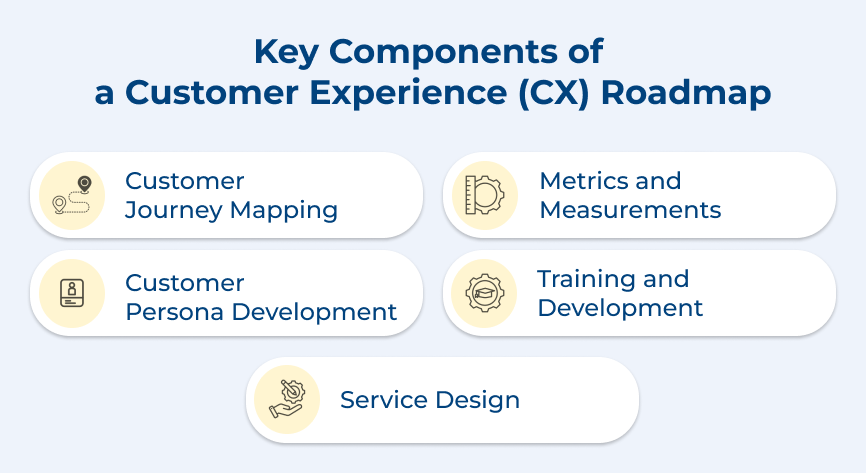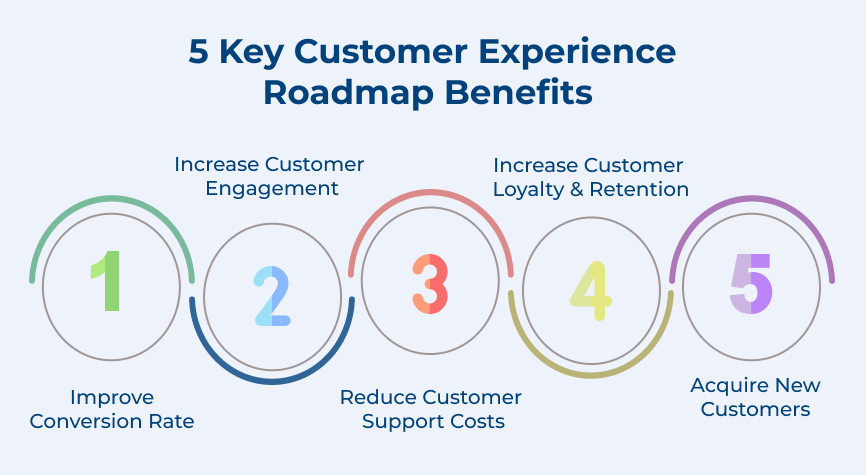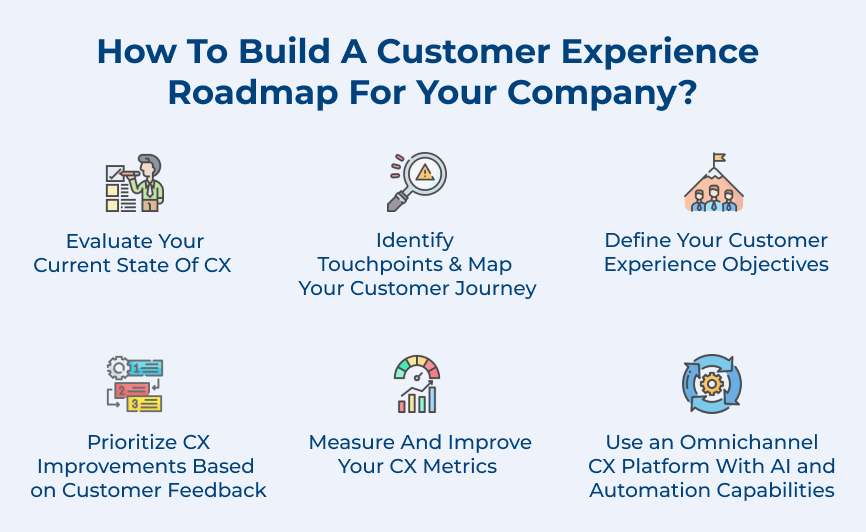1. Evaluate Your Current State of CX
Businesses initially need to evaluate their current level of customer experience. It can be done by collecting customer feedback and analyzing the business processes to identify areas of improvement. It’s worth partnering with a CX expert who can help the business understand the customers’ needs and identify elements that could negatively impact the customer experience.
Customer feedback helps to identify the pain points and challenges that customers experience. It provides valuable insights that can help to significantly improve the way a business serves its customers and offers a better experience.
Best practices:
- Conduct surveys or gather data about customer behavior to assess the current CX landscape and identify pain points in the customer journey.
- Use customer feedback to prioritize CX improvements and create a roadmap that aligns with business goals.
- Continuously analyze CX metrics to track progress and make informed updates to the roadmap.
2. Identify Touchpoints & Map Your Customer Journey
Once there is a clear understanding of the current CX state, the next step is to identify all touchpoints that a customer has with the business. The touchpoints could be online, offline, or a combination of both. They may include the website, social media profiles, phone line, email correspondence, in-store interactions and more.
After the identification of all touchpoints, it’s time to map out a customer journey for a greater experience. 86% of buyers are willing to pay more for a great customer experience. A customer journey map provides a visual representation of the end-to-end experience that a customer has when interacting with your business. It covers everything from initial awareness to post-purchase customer support.
Best practices:
- Prioritize touchpoints with the highest impact on customer satisfaction to ensure a more effective customer experience roadmap.
- Continuously update the customer journey map to reflect changes in customer preferences/behaviors and adjust the roadmap accordingly.
- Use data analytics and customer insights to identify personalized touchpoints throughout the customer journey, enhancing the overall experience.
3. Define Your Customer Experience Objectives
The next step towards building a CX roadmap is to define the customer experience objectives. Objectives should be SMART (specific, measurable, achievable, relevant and time-bound). Begin by identifying what the business wants to achieve by improving customer experience.
After identifying the objectives make sure to align them with the overall business goals. Identify the customer touchpoints that are most critical to the achievement of the objectives. The touchpoints could range from marketing, customer service and sales, to post-purchase engagement.
Best practices:
- Start by defining clear and measurable customer experience objectives that align with your business goals plus values.
- Make sure to involve all relevant stakeholders in the process to ensure buy-in and alignment.
- Use your customer experience objectives as a guide to map out your desired customer journey and identify areas for improvement.
4. Prioritize CX Improvements based on Customer Feedback
Closely listening to customer feedback and using it to inform decision-making is a vital component of improving customer experience. Gathering feedback could involve channeling surveys, conducting focus groups, social listening, or monitoring customer support interactions.
Make sure to gather feedback from various customer touchpoints. Use the insights to identify the top customer pain points and issues that need to be addressed. Prioritize areas of improvement that will have the most significant impact on customer satisfaction and overall experience.
Best practices:
- Start by gathering and analyzing customer feedback data to identify common pain points as well as the areas for improvement.
- Use customer feedback to prioritize CX improvements by focusing on the issues that have the biggest impact on customer satisfaction and loyalty.
- Create a customer experience roadmap that outlines specific action steps and timelines for implementing CX improvements.
5. Measure and Improve Your CX Metrics
Businesses must identify key metrics that can accurately measure the customer experience such as net promoter score, customer satisfaction score and customer effort score. Use the data to identify areas where customer demands are not being met. Make sure to take significant steps to improve the offerings.
Once businesses have identified areas of improvement, they can begin to implement solutions to enhance CX. It could involve optimizing customer service processes, enhancing online user experiences, or streamlining operations to make purchasing easier for customers.
Best practices:
- Choose the right metrics to measure, such as net promoter score or customer effort score, to gather accurate feedback from customers.
- Analyze the metrics to identify areas needing improvement and develop strategies to address them.
- Use customer insights to build a roadmap that aligns with the business goals and improves the overall customer experience.
6. Use an Omnichannel CX Platform with AI and Automation Capabilities
An omnichannel CX platform is a centralized tool that allows you to manage customer interactions across multiple channels such as email, social media and messaging apps. It provides a seamless experience and offers more personalized support. Due to the seamless communication experience, nearly 80% of customers prefer omnichannel strategies.
Implementing AI and automation capabilities within the platform will streamline your CX by automating routine tasks, such as scheduling appointments or sending follow-up emails. AI-powered chatbots can offer personalized recommendations to customers, respond accurately to their queries and drive sales.
Best practices:
- Ensure that the platform integrates with all relevant channels to provide a seamless customer experience across all touchpoints.
- Use automation capabilities strategically to free up human labor and increase efficiency.
- Continuously monitor and analyze customer behavior data to identify areas to optimize the CX roadmap accordingly.
Customer Experience Roadmap Examples (with Templates)
Check out the customer experience roadmap examples and provide you with templates to guide you in designing a journey that keeps your customers coming back for more.
Warby Parker
Warby Parker has designed a customer experience roadmap that sets them apart from traditional retailers. They offer a seamless online purchasing process, a home try-on program, and exceptional customer service to provide a hassle-free eyewear shopping experience. The brand focuses on personalization, affordability and convenience while maintaining a strong social mission. Warby Parker’s customer experience roadmap principle has been instrumental in their rapid growth and success.
A customer experience roadmap template in the D2C industry may include:
- Simplified purchasing process: D2C brands focus on creating frictionless online shopping experiences, reducing steps in the purchasing process and offering one-click or subscription-based options to enhance convenience.
- Engaging content and community building: D2C brands often invest in content marketing, social media customer engagement and community-building activities to create meaningful connections with their customers.
Nordstrom
Nordstrom is widely recognized for its exceptional customer service and experience. Their customer experience roadmap principle revolves around creating a welcoming and personalized shopping environment. Nordstrom invests in employee training to ensure that they deliver exemplary service, offer personalized styling assistance, and provide a seamless omnichannel experience.
A customer experience roadmap template in retail can involve:
- Personalized in-store experience: Retail brands implement technologies like beacon technology and augmented reality to offer personalized recommendations.
- Seamless online shopping: Retailers ensure their online platforms are user-friendly, mobile-responsive and optimized for easy navigation .
Salesforce
Salesforce excels in providing a seamless customer experience. They have created a comprehensive customer journey map that outlines touchpoints from awareness to post-purchase support. Their roadmap focuses on personalized interactions, efficient onboarding, ongoing training and responsive customer support. They also leverage user data and feedback to continuously improve their offerings .
A customer experience roadmap template often includes:
- User-friendly onboarding: SaaS companies understand the importance of a smooth onboarding process. They prioritize creating tutorials, helpful guides, and interactive demos to help new users quickly understand .
- Continuous Support: SaaS companies typically offer customer support through multiple channels such as chat, email, and phone. They ensure a prompt and knowledgeable response to address any technical issues or customer inquiries promptly.
Nike
Nike places customer experience at the core of its strategy. They have established a customer-centric roadmap that focuses on understanding and meeting the unique needs of individual customers. Nike leverages data analytics to offer personalized product recommendations, seamless online shopping experiences and immersive in-store experiences.
A customer experience roadmap template in this industry can involve:
- Omnichannel presence: B2C brands understand the significance of reaching customers through various touchpoints. They create a cohesive and seamless experience across multiple channels .
- Personalization and customization: B2C brands personalize their offerings, tailor marketing communications and recommend relevant products or services based on a customer’s preferences.
The Ritz-Carlton
The Ritz-Carlton is renowned for its exceptional customer experience. Their customer experience roadmap is built on their motto “We are Ladies and Gentlemen serving Ladies and Gentlemen.” The brand focuses on providing personalized service, anticipating guest needs and exceeding expectations at every touchpoint. From warm greetings to customized amenities, The Ritz-Carlton aims to create unforgettable experiences that keep guests coming back.
The template in this industry might include:
- Pre-Stay personalization: Hospitality brands collect guests’ preferences to offer personalized recommendations, room customization and tailored experiences before their arrival .
- Proactive customer service: Hotels and restaurants prioritize personalized service, training their staff to anticipate guests’ needs, and resolve issues efficiently through welcome amenities or personalized greetings.
Challenges to Implement Customer Experience Roadmap (& How to Avoid Them)
Below are the key challenges that businesses often face when implementing their customer experience roadmap along with the solutions to ensure a smooth journey towards customer satisfaction excellence.
Resistance to Change
One of the most significant challenges in implementing a customer experience roadmap is resistance to change. It can come from both the top management and front-line employees. Many companies prefer the status quo and have trouble adjusting to new procedures .
Companies must prioritize communication and collaboration with all the teams involved in the implementation. They need to understand the business strategy and how the roadmap fits within it. Frequent communication, training and feedback are key to a successful implementation.
Incomplete Customer Journey Maps
Companies can create an effective customer experience roadmap by defining both internal and external processes across the entire customer journey. It includes defining it from the first point of contact to conversion and beyond.
Companies can avoid such scenarios by focusing on gathering feedback from their customers. The insights must be closely analyzed to identify gaps in the customer journey. Work backward to stitch together the customer experience, considering customer expectations and redefining internal processes to fit their expectations.
Inadequate Data Collection and Analysis
A customer experience roadmap relies heavily on data. It can be difficult to identify the potential customers’ needs, wants and pain points without any data.
Businesses can overcome such challenges by identifying the right metrics to measure customer experience and defining a process to collect data. A strong data governance program is key to consistent, reliable and accurate data.
Lack of Ownership and Accountability
Another potential obstacle is the lack of ownership and accountability. Different teams or employees could be working on different aspects of the customer experience. It can lead to confusion, inconsistency and a lack of accountability.
Clearly define accountability roles for each team member, assign KPIs and hold everyone accountable for their role in the roadmap’s implementation. Such an approach ensures the team functions cohesively.
Overarching External Factors
Even with a perfect roadmap, external factors such as technology disruption or changes in consumer behavior can derail its implementation.
Businesses should proactively monitor market trends and emerging technologies while facilitating cross-functional collaboration. The proactive and adaptive strategy ensures that external influences do not hinder the pursuit of effective customer experience initiatives.
Customer Experience Roadmap to Drive Customer-Centric Success
A well-crafted customer experience roadmap is not just a plan; it’s a strategic journey towards lasting success. Implementing the proven strategies outlined will allow you to build a roadmap that places the customer at the heart of the business.
A CX journey involves understanding your customers deeply, designing seamless personalized interactions, proactively resolving issues and leveraging technology for excellence.
Always remember the roadmap is a dynamic tool that evolves with your customers and your organization. Stay agile, list en to feedback and keep refining your approach. A customer-centric roadmap in place ensures the business is not just meeting expectations; it’s exceeding them, building loyal advocates and securing a bright future.














